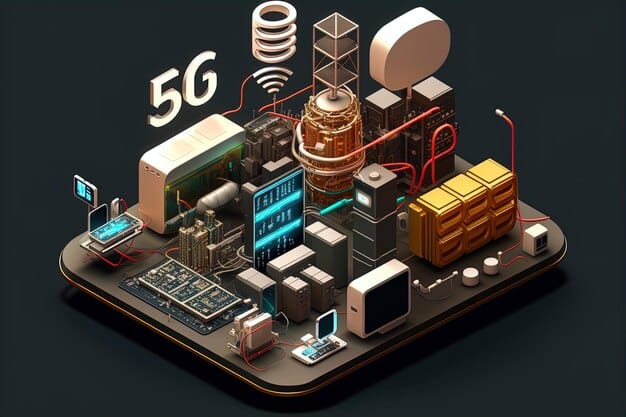How 5G Network Slicing Will Transform US Industries by 2025

5G network slicing enables the creation of multiple virtual networks within a single physical 5G network, allowing US industries to tailor connectivity for specific needs, driving innovation, efficiency, and new revenue streams by 2025.
By 2025, 5G network slicing is poised to revolutionize various US industries. This innovative technology allows mobile operators to divide a single physical 5G network into multiple virtual networks, each tailored to meet the specific requirements of different applications and services.
Understanding 5G Network Slicing
5G network slicing is a game-changing technology that enables mobile operators to create multiple virtual networks on top of a shared physical infrastructure. This allows for the customization of network resources, such as bandwidth, latency, and security, to meet the specific needs of different applications and industries.
Unlike traditional networks that offer a one-size-fits-all approach, 5G network slicing provides the flexibility and agility required to support a wide range of use cases, from enhanced mobile broadband (eMBB) to massive machine-type communications (mMTC) and ultra-reliable low-latency communications (URLLC).
Key Components of Network Slicing
Several key components enable the functionality of 5G network slicing.
- Network Functions Virtualization (NFV): NFV allows network functions to be decoupled from dedicated hardware and run as software on standard servers.
- Software-Defined Networking (SDN): SDN provides centralized control and management of the network, enabling dynamic allocation of resources and automated provisioning of slices.
- Orchestration and Management: This component is responsible for creating, modifying, and deleting network slices, as well as monitoring their performance and ensuring that they meet the defined service level agreements (SLAs).
These components work together to create end-to-end network slices that can be customized to meet the specific needs of different industries and applications.

In conclusion, 5G network slicing represents a paradigm shift in network architecture, providing the flexibility, scalability, and performance required to support the diverse needs of modern industries.
Transforming the Healthcare Industry
The healthcare industry is ripe for revolution through 5G network slicing. Imagine remote surgeries with zero latency and real-time monitoring of patient vitals from anywhere in the world. Network slicing makes this a tangible reality by providing dedicated, reliable, and secure connections tailored specifically for healthcare applications.
From telemedicine to remote patient monitoring and robotic surgery, 5G network slicing can transform healthcare delivery, improve patient outcomes, and reduce costs.
Remote Patient Monitoring
5G network slicing enables continuous and reliable remote patient monitoring, allowing healthcare providers to track vital signs and detect potential health issues before they become critical.
This is particularly beneficial for patients with chronic conditions, elderly individuals living alone, and those recovering from surgery at home.
- Real-time data transmission from wearable sensors and medical devices.
- Secure and private communication between patients and healthcare providers.
- Early detection of health anomalies and timely intervention.
In summary, 5G network slicing empowers the healthcare industry to deliver more efficient, personalized, and accessible care to patients, regardless of their location.
Revolutionizing Manufacturing Processes
The manufacturing sector stands to gain significantly from the implementation of 5G network slicing. By enabling ultra-reliable, low-latency communication, it can facilitate automation, enhance quality control, and improve overall operational efficiency.
Factories of the future will leverage 5G network slicing to connect a multitude of sensors, robots, and machines, enabling real-time data analysis and optimized decision-making.
Smart Factories and Automation
5G network slicing enables the creation of smart factories with advanced automation capabilities.
By providing dedicated and reliable connectivity, it allows for seamless communication between machines, robots, and control systems.
- Real-time monitoring of production processes.
- Automated quality control and defect detection.
- Predictive maintenance to minimize downtime.

In conclusion, 5G network slicing revolutionizes manufacturing by enabling intelligent automation, optimized processes, and improved productivity, paving the way for the factories of the future.
Enhancing the Transportation Sector
The transportation industry is on the cusp of a significant transformation, driven by 5G network slicing. Autonomous vehicles, smart traffic management systems, and enhanced passenger experiences are just a few of the possibilities that this technology unlocks.
By providing reliable, low-latency communication, 5G network slicing can improve safety, efficiency, and sustainability in the transportation sector.
Autonomous Vehicles and Connected Cars
5G network slicing is a critical enabler for autonomous vehicles and connected car technologies.
It allows for real-time communication between vehicles, infrastructure, and cloud-based control systems.
- Enhanced safety through vehicle-to-vehicle (V2V) and vehicle-to-infrastructure (V2I) communication.
- Improved traffic flow through smart traffic management systems.
- Real-time navigation and route optimization.
In summary, 5G network slicing has the potential to revolutionize transportation by enabling safer, more efficient, and more sustainable mobility solutions.
Reshaping the Entertainment and Media Industry
The entertainment and media industry is constantly evolving, and 5G network slicing is set to play a pivotal role in shaping its future. From immersive virtual reality (VR) experiences to high-definition video streaming and interactive gaming, this technology enables new levels of engagement and interactivity.
By providing dedicated bandwidth and ultra-low latency, 5G network slicing can deliver seamless and immersive entertainment experiences to users, regardless of their location.
Immersive Virtual Reality Experiences
5G network slicing enables immersive virtual reality (VR) experiences that were previously impossible.
By providing dedicated bandwidth and ultra-low latency, it allows for real-time streaming of high-resolution VR content.
- Seamless and lag-free VR gaming and entertainment.
- Remote collaboration and training in virtual environments.
- Immersive virtual tourism and cultural experiences.
In conclusion, 5G network slicing transforms the entertainment and media industry by enabling new and immersive experiences, enhancing user engagement, and unlocking new revenue streams.
Driving Innovation in the Public Safety Sector
The public safety sector relies on reliable and secure communication networks to protect citizens and respond to emergencies. 5G network slicing provides the dedicated and prioritized connectivity that first responders need to effectively carry out their duties.
From real-time video surveillance to drone-based situational awareness and enhanced communication between emergency responders, 5G network slicing can improve public safety outcomes and save lives.
Real-Time Video Surveillance
5G network slicing enhances real-time video surveillance capabilities for public safety agencies.
It allows for the transmission of high-resolution video feeds from surveillance cameras and drones to command centers in real-time.
- Improved situational awareness for law enforcement and emergency responders.
- Enhanced ability to monitor and respond to public safety incidents.
- Real-time analysis of video data to identify potential threats.
In summary, 5G network slicing strengthens the public safety sector by providing reliable, secure, and prioritized communication networks that enable rapid response and improved situational awareness.
| Key Aspect | Brief Description |
|---|---|
| 🚀 Healthcare | Enables remote monitoring and telemedicine advancements. |
| 🏭 Manufacturing | Drives automation and efficiency in smart factories. |
| 🚗 Transportation | Supports autonomous vehicles and smart traffic solutions. |
| 🎬 Entertainment | Enhances VR/AR experiences for media consumption. |
Frequently Asked Questions
5G network slicing is the ability to create multiple virtual networks over a shared physical infrastructure, each optimized for specific applications and use cases. It allows for customized connectivity.
It enables advancements like remote patient monitoring, telemedicine, and robotic surgery by providing reliable, low-latency connections that transmit real-time data necessary for critical applications.
Slicing allows for enhanced automation, predictive maintenance, and real-time quality control in smart factories, leading to improved operational efficiency and reduced downtime.
It supports autonomous vehicles, intelligent traffic management, and real-time navigation, leading to safer, sustainable, and efficient transportation systems with better V2V and V2I communication.
5G slicing allows for lag-free VR/AR and high-definition streaming, offering immersive experiences for gaming and entertainment, while also facilitating remote collaboration in virtual environments.
Conclusion
In conclusion, 5G network slicing offers transformative potential across US industries by 2025. Its ability to customize network resources to specific needs drives innovation, improves efficiency, and enables new revenue streams, reshaping healthcare, manufacturing, transportation, entertainment, and public safety.





